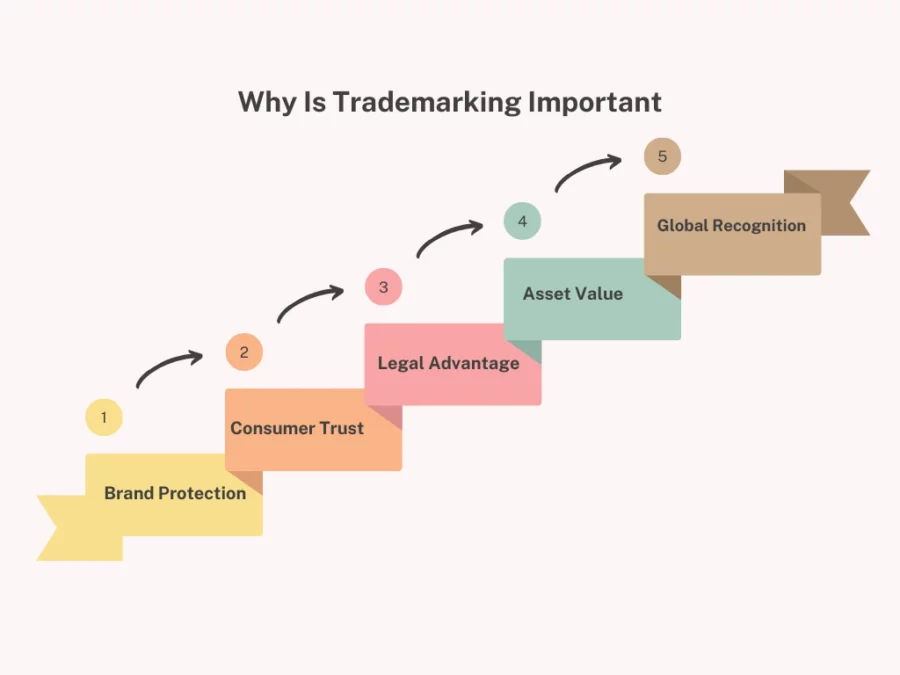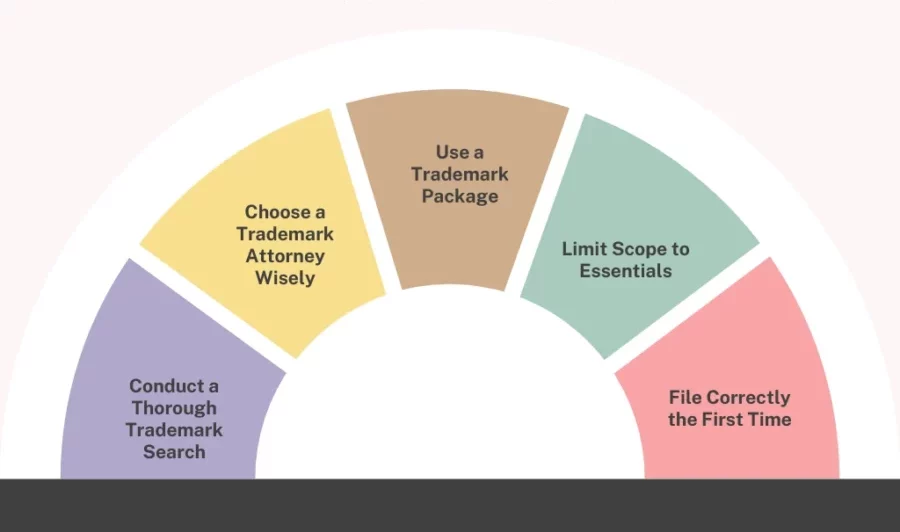Key Takeaways:
- File directly through the USPTO for a cost-effective option, ensuring you thoroughly research existing trademarks first.
- Affordable online platforms can guide you through the trademark process with lower fees than hiring traditional attorneys.
- For local protection for businesses, state-level registration is cheaper and simpler than federal but offers limited geographical rights.
Trademarking a name is a critical step for businesses looking to protect their brand and distinguish themselves in the marketplace. However, many entrepreneurs and startups are often deterred by the perceived high costs and complex processes associated with trademark registration.
The good news? Securing a trademark doesn’t have to break the bank or become an overwhelming endeavor. With the right approach, you can trademark a name affordably while safeguarding your brand’s identity.
Whether you’re launching a new product, service, or business, a trademark ensures that your unique brand name is legally protected, preventing others from using it and causing potential market confusion.
While hiring a traditional trademark attorney can offer peace of mind, it often comes with hefty fees that small businesses or solo entrepreneurs may find challenging.
Thankfully, there are more budget-friendly registration process available today. From self-filing through the United States Patent and Trademark Office (USPTO) to leveraging online trademark services that streamline the process, you have choices that fit various budgets.
Even considering state-level registrations can provide an economical alternative for businesses with more localized reach. By exploring this affordable way to trademark a name, protect your brand, and stay within budget—all with confidence and clarity.
Protect Your Brand & Recover Revenue With Bytescare's Brand Protection software
What Is a Trademark?
A trademark is a unique symbol, word, phrase, design, or combination that identifies and distinguishes the products or services of one business from those of others. It acts as a badge of origin, ensuring consumers can recognize a brand and associate it with a specific level of quality and reputation.
Trademarks help protect a company’s brand identity and prevent competitors from using similar marks that could confuse customers.
Trademarks can be registered at both state and federal levels, with federal registration through the United States Patent and Trademark Office (USPTO) offering enhanced protection across the country.
Registering a trademark grants the owner exclusive rights to use the mark and enhances legal standing if disputes or infringements arise, making it a key asset for brand protection.
What Are the Different Types of Trademarks?
| Type of Trademark | Description | Examples |
| Word Marks | A text-only representation of a brand, such as a single word or a phrase. | “Nike,” “Coca-Cola,” “Apple” |
| Design Marks (Logos) | Visual symbols, images, or designs used to represent a brand. | McDonald’s golden arches, Nike swoosh |
| Combined Marks | A combination of words and design elements used together as a brand identifier. | Starbucks logo with the brand name |
| Service Marks | It is used to identify services instead of physical products. | FedEx (delivery services), Hilton (hotel services) |
| Collective Marks | Used by people who are part of an association to show that they are members. | CPA (Certified Public Accountant), NFL (National Football League) |
| Certification Marks | The certification trademark indicates that products or services meet specific standards set by a certifying organization. | USDA Organic, Energy Star |
| Color Marks | Certain colors that are linked to the reputation of a brand. | Tiffany & Co.’s robin egg blue |
Why Is Trademarking Important?

Trademarking is essential for protecting your business’s unique identity and brand image. A trademark can be a symbol, word, logo, or combination that distinguishes your products or services from those of competitors. Here are the advantages of trademark registration:
By registering a trademark, you protect your brand’s assets legally. It only lets the business owner use the brand. Other people cannot use a similar mark in commerce, which could confuse consumers.
Consumer Trust
A trademark shows that your business is trustworthy. Consumers will stick with your business more if they think of your name as a sign of consistent quality. This trust is important for establishing your brand in the marketplace.
Legal Advantage
If another company tries to use your trademark, you can legally prevent them from using it if you register your trademark. You can use the law to protect your rights or seek compensation from infringers if necessary.
Asset Value
Trademarks are intangible assets that add value to your business. A trusted trademark can add a lot to the value of a business, which makes it a valuable tool if you want to grow.
Global Recognition
Trademark registration can extend beyond your country, allowing legal protection against infringement in international markets. The benefits of trademark registration make sure that your brand stays the same as your business grows around the world.
Protect Your Brand & Recover Revenue With Bytescare's Brand Protection software
What Are the Initial Steps to Prepare for Trademarking?
You need to take a number of smart steps to make sure your initial trademark application is successful. These are the first steps:
Conduct a Thorough Trademark Search
- Before applying for a trademark, it’s vital to do a basic trademark search to check if a similar mark already exists.
- Use databases like the U.S. Patent and Trademark Office (USPTO) or relevant trademark offices in your country to search for existing trademarks.
- The initial trademark search helps you stay away from potential legal disputes or the risk of a rejected application.
Determine the Scope of Protection
- Specify the products or services that your trademark will protect.
- When trademarks are registered, they fall into different classes that each cover a distinct category of offerings.
- Selecting the right class or multiple classes is very important for complete legal protection.
Ensure Distinctiveness
- It is important that your trademark is unique.
- It is harder to protect overly descriptive marks legally.
- Any unique word, image, or symbol can be used as a distinctive mark. It will have a better chance of being registered.
Develop a Trademark Strategy
- Think about how you want to use your trademark as well as any expansion plans.
- If you want to do business in other countries, you might want to look into getting legal protection in those places through methods like the Madrid Protocol for global trademarks.
Prepare Documentation
- Obtain the needed paperwork, like proof of use, to back up the trademark application.
- This can have images of your company’s logo or examples of its use in business.
What Is the Affordable Way to Trademark a Name?

Conducting a Trademark Search Yourself
Before you apply for a trademark, you need to do a basic trademark search to make sure there are no legal issues. It helps you make sure that the name you want to use is not already being used. This saves you money that would have been spent on rejected applications or infringement disputes.
Steps to Conduct a Search Using the USPTO’s TESS Database
- Access TESS: Go to the USPTO’s website and navigate to the Trademark Electronic Search System (TESS).
- Choose Search Option: Start with the “Basic Word Mark Search (New User)” for simple queries or “Word and/or Design Mark Search (Structured)” for advanced searches.
- Enter Keywords: Type in your proposed trademark. For detailed results, use Boolean operators like AND and OR.
- Review Results: Carefully go through all of the records to find any potential issues. Look at marks that are listed under the same classes that are similar in appearance or meaning.
Common Mistakes to Avoid
- Ignoring Similar Marks: Overlooking trademarks that are not identical but similar can lead to rejections.
- Narrow Search Scope: Not searching in related classes can result in an incomplete assessment.
- Assuming Unregistered Marks Don’t Matter: Remember that common law rights may still protect unregistered trademarks.
DIY Trademark Application Process
The U.S. Patent and Trademark Office (USPTO) allows individuals to file trademark applications online through the Trademark Electronic Application System (TEAS). In this process, you have to file and keep track of your application until a decision is made.
Step-by-Step Guide for Trademark Registration Application
| Create a USPTO Account | Sign up on the USPTO website to access the Trademark Electronic Application System (TEAS). |
| Choose the Correct TEAS Form | Select between TEAS Plus (lower fees, stricter requirements) or TEAS Standard (higher fees, fewer requirements). |
| Provide Trademark Owner Information | Enter your name, business name (if applicable), and contact details. |
| Enter Trademark Details | Specify if the mark is a word, logo, or combination, and provide a description. |
| Classify Goods/Services | Identify the classes that your trademark covers (e.g., clothing, technology). |
| Select Basis for Filing | Indicate if the application is based on “use in commerce” or “intent to use.” |
| Upload Specimens | Attach evidence of the trademark’s use, such as product images or marketing materials. |
| Review and Submit | Double-check all details and the application fee for accuracy, sign the application, and submit it online. |
Tips for Accuracy
- Double-check Classification: Make sure that the offerings are listed properly to avoid rejections.
- Submit Clear Specimens: Blurry or non-compliant evidence can lead to delays or refusals.
- Verify Contact Details: Providing incorrect information can cause missed communications or extra fees.
Leveraging Online Trademark Services
The average cost for online trademark services typically ranges from $100 to $500. Basic filing services, including trademark search and application submission, often fall on the lower-end filing fees, around $100 to $200. Comprehensive packages with additional features like trademarking expert legal advice, trademark monitoring, or expedited trademarking process can cost between $300 and $500.
Additional fees may apply for multiple trademark classes, international filings, or extended legal support. When choosing a service, you should think about your needs since costs can change based on the complexity of the application.
Pros and Cons of Using Online Legal Service Providers
| Pros | Cons |
| File from anywhere, anytime. | Might not be able to provide detailed legal assistance. |
| Typically cheaper than hiring a traditional attorney. | Extra costs for features like expedited processing or additional classes. |
| Step-by-step instructions help ensure proper filing. | Without expert review, mistakes may occur in the application. |
| Streamlined processes lead to quicker submission and responses. | Standardized solutions may not cater to complex cases. |
| Easy to access and use, even for first-time applicants. | It might not address specific legal needs. |
Protect Your Brand & Recover Revenue With Bytescare's Brand Protection software
What Are the Low-Cost Alternatives and Strategies?

Filing Through State Trademark Registrations
State and federal trademark registration differ primarily in the scope of protection and the application process. A state trademark offers valuable protection in the state where it’s filed. A federal trademark protects you all over the nation, including in U.S. regions and on international markets through treaties.
The federal application process is handled by the USPTO and is more complex and costly, typically ranging from $225 to $400, whereas state registrations are simpler and more affordable, costing around $50 to $150.
Federal trademark protection also offer stronger legal rights, including the ability to use the ® symbol and access federal courts for enforcement.
| Advantages of State Trademarking | Limitations of State Trademarking |
| Typically less expensive (around $50 to $150). | Valid only within the state of registration. |
| Quicker approval compared to federal registration. | Does not extend outside the state. |
| Simpler application process with fewer requirements. | State trademarks lack the national status of federal ones. |
| Ideal for businesses operating solely within one state. | May be harder to defend in federal court or on a national level. |
While state trademark registrations are cheaper, they don’t offer limited protection. Federal registrations cost more, but they offer greater protection.
Using a Trademark Attorney for Basic Services
- When hiring a trademark attorney on a budget, you can expect a straightforward, cost-effective package focused on essential services.
- Basic trademark packages typically include a trademark search to check for conflicts, preparing and filing your application with the relevant trademark office, and initial legal advice on protecting your brand.
- To manage costs, inquire about flat-fee pricing rather than hourly rates, as this helps avoid unexpected expenses.
- Some law firms offer reduced rates for specific tasks, so discuss which services are essential for your needs and opt for only those.
- If your trademark application faces issues, ask if you can pay for additional support as needed rather than bundling every service upfront.
- You will only pay for the services you need while still receiving professional protection for your intellectual property if you and the service provider are clear about the scope of services and how much they cost.
Tips for Reducing Costs During the Trademark Process

To lower costs during the trademark process, you need to plan ahead. If you want to keep costs low while still protecting your brand, here are some useful tips:
Conduct a Thorough Trademark Search
Before hiring an attorney, conduct your own preliminary trademark search using free online databases like the USPTO’s TESS. This will help you find any possible trademark issues, which will save you money on a more detailed search later.
Choose a Trademark Attorney Wisely
Shop around and compare pricing. Many attorneys offer flat-rate fees for basic trademark services, which can be more affordable than hourly billing. Ensure that the attorney you hire specializes in trademarks but is also willing to tailor their services to your budget.
Use a Trademark Package
Many trademark attorneys offer bundled services at a reduced rate, which typically include the trademark search, application filing, and basic advice. Choose the package that fits your needs without overpaying for unnecessary services.
Limit Scope to Essentials
Focus on what’s most important—filing the trademark application and ensuring it’s done correctly. Avoid add-ons like expansive international protection unless absolutely necessary. If there are office actions or follow-up steps, consider handling them yourself or negotiating a lower rate for minimal assistance.
File Correctly the First Time
Errors in your application can delay the process and increase costs. Take your time to ensure the application is accurate, including selecting the correct trademark class and description.
Potential Pitfalls and How to Avoid Them
The trademark process can be complex, and there are several potential pitfalls that could delay or increase the cost of securing your trademark. Here’s how to avoid them:
Inaccurate Application Details
- One of the most common mistakes is submitting an application with incorrect or incomplete information, such as a vague trademark description or the wrong trademark class.
- To avoid this, thoroughly research the trademark categories and ensure your description accurately reflects the goods or services associated with your brand.
Failure to Conduct a Proper Trademark Search
- Neglecting to conduct a comprehensive trademark search can lead to conflicts with existing trademarks, resulting in costly legal disputes or application rejections.
- To prevent this, always perform a detailed search before filing, and consider hiring a professional to do a thorough check if you’re unsure.
Improper Trademark Use
- After filing, it is essential to actively use your trademark in commerce.
- Failing to use the trademark can lead to abandonment.
- Make sure you meet the legal requirements for trademark use in the marketplace to maintain your rights.
Ignoring Renewal Deadlines
- Trademarks require periodic renewals to maintain protection.
- Missing a renewal deadline can result in losing your trademark rights.
- Set reminders for key renewal dates and stay on top of application for renewal deadlines.
Choosing a Trademark That’s Too Generic
- Trademarks that are too generic or descriptive are difficult to protect.
- Be strategic about choosing a strong, unique mark that can be differentiated from competitors in your industry.
Maintaining Your Trademark Affordably
Maintaining your trademark is crucial to ensure long-term protection, but it doesn’t have to be expensive. Here are some cost-effective strategies to help you manage ongoing trademark maintenance:
Know Renewal Fees
Trademark renewal costs vary by jurisdiction, but in the U.S., the USPTO requires renewal between the 5th and 6th year and then every 10 years after that.
The current filing fee for renewal typically ranges from $200 to $400 per class of goods or services, depending on whether you file online or through other means. Be aware of this actual cost so you can budget accordingly and avoid surprises.
Stay Ahead of Renewal Deadlines
One of the easiest ways to avoid late renewal penalties is to stay organized. Mark your calendar with key renewal dates and set reminders well in advance.
If you miss a renewal application deadline, you may face additional fees, or even risk losing your trademark protection altogether. Filing early can help ensure your rights remain intact without incurring extra charges.
Monitor Use of Your Trademark
Regularly check that your trademark is being actively used in commerce, as non-use can lead to its cancellation. If you’re operating on a tight budget, consider implementing a simple trademark monitoring process where you check on your mark’s usage every few months.
Use Trademark Watch Services
For ongoing protection, consider subscribing to an affordable trademark watch service to monitor for potential infringement. These services can help you spot unauthorised uses of your trademark, allowing you to take action quickly without the need for costly litigation.
What’s Next?
Trademarking a name doesn’t have to be expensive. By following strategic steps, you can protect your brand affordably. Start by conducting a thorough trademark search on your own or through budget-friendly online tools to avoid conflicts before filing.
Choose a trademark lawyer who offers flat-rate services, or consider using a trademark filing service for a more cost-effective option. Ensure you file the application accurately to prevent costly mistakes or reapplications.
Additionally, stay organised with renewal dates to avoid late fees and penalties. With careful planning and smart choices, you can secure and maintain your trademark without breaking the bank, ensuring long-term protection for your brand.
Bytescare Brand Protection helps you maintain global brand integrity and safeguard your presence on major social media platforms. With a customisable, real-time dashboard, you overcome jurisdictional challenges and ensure effective brand security.
Protect your brand and gain a competitive edge. Contact us for comprehensive, worldwide brand protection solutions!
The Most Widely Used Brand Protection Software
Find, track, and remove counterfeit listings and sellers with Bytescare Brand Protection software

FAQs
What is the cheapest way to trademark a name?
The cheapest way is to file directly with the U.S. Patent and Trademark Office (USPTO) through their online system, using their TEAS Plus application, which costs around $250 per class of goods or services.
How much it costs to trademark a name?
The cost of trademark registration typically costs between $225 and $400 per class of goods or services, depending on whether you use the USPTO’s TEAS Plus or TEAS Standard application.
Can I trademark a name without a lawyer?
Yes, you can trademark a name without a lawyer by filing directly with the USPTO, though legal assistance is recommended to ensure accuracy and avoid potential issues.
How long does it take to register a trademark?
The period of time it typically takes 8-12 months to register a trademark with the USPTO, depending on the complexity of the application and any potential legal challenges or objections.
What happens if my trademark application is rejected?
If rejected, you can respond to office actions or appeal the decision. You may need to amend your application or address any issues raised by the USPTO examiner.
How to trademark a word for free?
Trademarking a word for free isn’t possible, but you can reduce cost of registration by filing yourself with the USPTO, paying only the trademark fee without involving an attorney. However, professional advice is often beneficial.
Ready to Secure Your Online Presence?
You are at the right place, contact us to know more.

